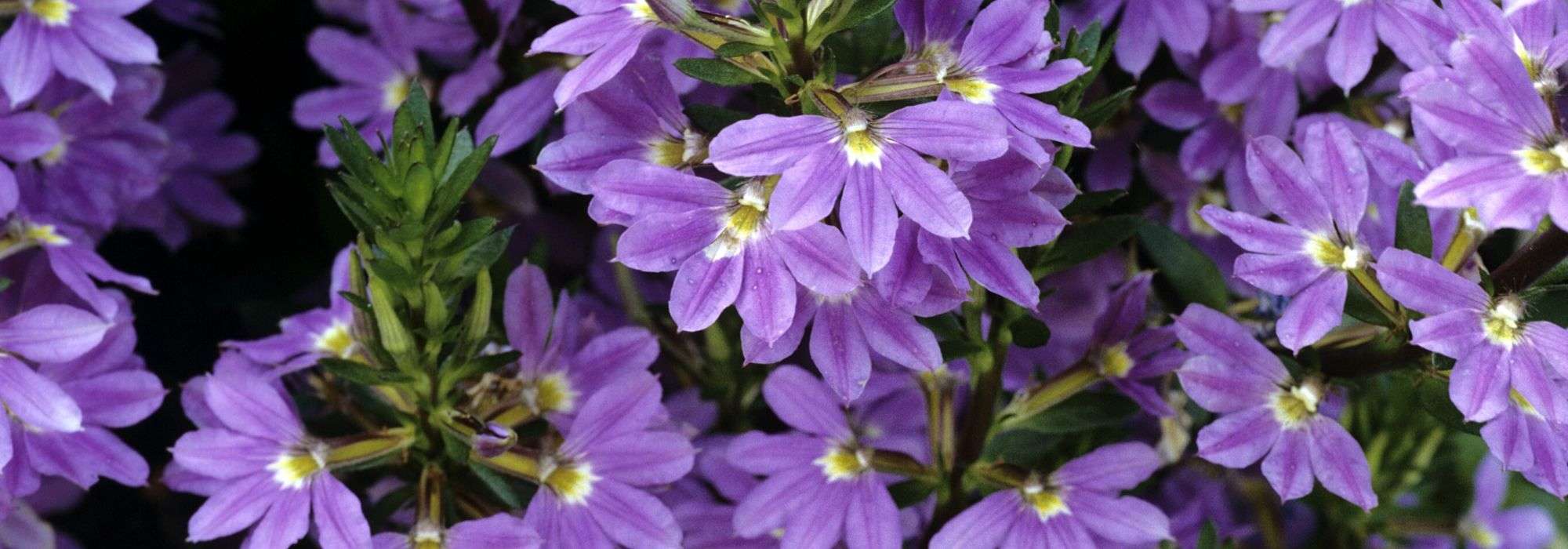
Scaevola: planting, growing
Contents
Scaevola in a nutshell
- Scaevola is a beautiful annual that flowers from spring to autumn
- Its small fan-shaped flowers come in shades of blue, white, pink, or yellow
- Fast-growing and drought-resistant, it is easy to grow
- It requires only regular watering, but not excessive
- Trailing or carpet-forming, it will flourish within a few weeks in your pots, hanging baskets, or as groundcover in your summer beds
A word from our expert
Scaevola aemula is an outstanding annual known for its generous flowering that lasts from May until the first frosts. It tirelessly produces countless small, fan-shaped flowers throughout the beautiful season, in shades of blue (Scaevola ‘Saphira’, Scaevola ‘Surdiva Blue’), white, pink (‘Pink Charm’), or yellow, earning it the nickname “fan plant” or “fairy fan flower.”
Its name (scaevola), meaning “left-handed” in Italian, refers to the Roman hero Gaius Mucius Scaevola, who in 508 BC sacrificed his right hand to fire to demonstrate the strength of his faith in the Republic of Rome, which was at war with the Etruscan Empire.
Native to the coastal regions of Australia, Scaevola is frost-sensitive and will be grown as an annual plant in most of our regions. However, it can withstand full ground conditions in gardens with a mild climate or by the seaside.
It requires only a sunny or partially shaded position, along with regular watering, to thrive.
This trailing plant is ideal for hanging baskets, window boxes, and pots, and can be combined with other summer flowers to create beautiful displays. Full of freshness, it is also suitable for dressing up borders, rockeries, or small edges until autumn.
Discover this lovely flowering annual that is essential in summer and choose from our unique collection of annual flowers!
Description and botany
Botanical data
- Latin name Scaevola aemulus, Scaevola aemula
- Family Goodeniaceae
- Common name Scaevola, Fan flower, fan plant
- Flowering May to October
- Height 0 to 0.40 m
- Exposure Sun, partial shade
- Soil type Well-drained
- Hardiness Frost-sensitive
Scaevola, also known as the “fairy fan flower”, is a herbaceous perennial plant belonging to the Goodeniaceae family. It is native to the Australian coasts. The genus comprises 86 species, almost all of which are of subtropical origin, making them frost-sensitive. Perennial in its native habitat, it is cultivated as an annual in our climates.
The most commonly cultivated species is Scaevola aemulus (or Scaevola aemula), which produces white or blue flowers and has given rise to numerous varieties.
The Scaevola forms a bushy, spreading clump with a creeping or trailing habit, depending on the cultivars, rarely exceeding 40 cm in height and the same in width. The regular introduction of new varieties enhances the forms and possibilities for use.
The growth is very rapid. It spreads through its long, flexible, ramified stems that become lignified at the base and can reach up to 60 cm in length. These stems bear thick, slightly succulent, glossy, and granulose foliage. It can persist in gardens with mild climates. The leaves are small but broad at the base, stemless, spatulate, tapering to a point, and broadly dentate. They are light green to dark green in colour.
This dense and vigorous vegetation is hidden beneath cascades of flowers. Flowering from spring until the first frosts, the Scaevola is remarkable for its very long flowering period. It begins in April and lasts until October, or even longer depending on the climate, in the form of long spikes of terminal clusters composed of small flowers. Measuring 2 to 3 cm across, they are grouped in the axils of the upper leaves. They are stemless and consist of 5 rounded, fused petals forming a characteristic fan shape. This unique appearance has earned the plant the poetic nickname of “fairy fan flower”. Some have crinkled petals that are sometimes very undulate (‘Topaze Pink Improved’).
They come in all shades of blue, violet-blue, lilac-blue, lavender blue, as well as white, canary yellow, or even candy pink. Some cultivars are subtly coloured in two tones. Their throat is illuminated by a contrasting yellow heart often bordered by a white halo that enhances the colour of the corolla.
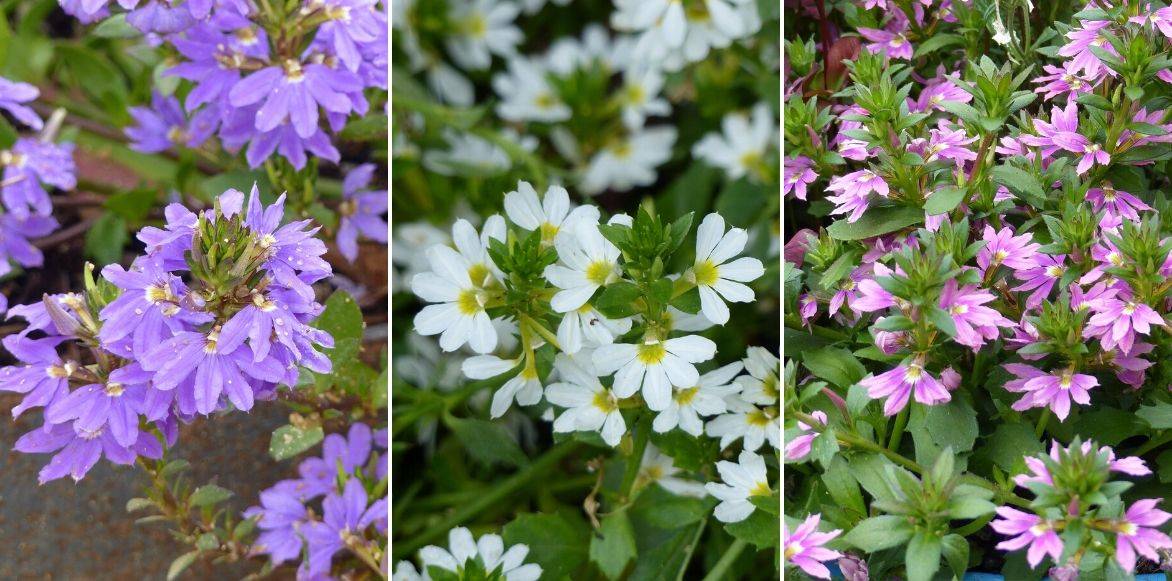 Scaevola comes in several colours
Scaevola comes in several colours
This endless flowering attracts a large number of pollinating insects. Once fertilised, they transform into small drupes containing flat seeds.
Very floriferous and with rapid growth, the Scaevola requires a light, humus-rich but especially well-drained, rather dry soil. It has now become essential on balconies and terraces, in hanging baskets, window boxes, or pots. The excellent hold of its flowering stems also allows for planting in the ground along borders, pathways, or in rockeries.
The name Scaevola, meaning “left-handed” in Italian, is derived from Caius Mucius Scaevola, a young Roman hero who, in 508 BC, thrust his right hand into the fire to impress the Etruscans against whom the Roman Republic was at war.
“`
Our favourite varieties
The multiple cultivars and new hybrids of the species type Scaevola aemulus are increasingly numerous and vary in their habit, which can be more or less upright, and in flower colour (blue, white, pink, or yellow).
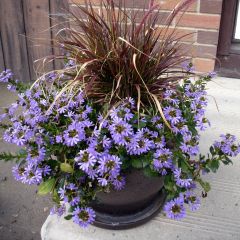
Scaevola aemula Surdiva Blue
- Flowering time June to November
- Height at maturity 40 cm
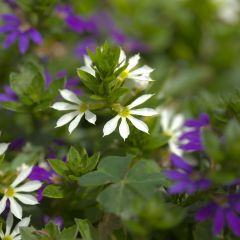
Scaevola aemula Surdiva White
- Flowering time June to November
- Height at maturity 80 cm
Discover other Scaevola
View all →Available in 0 sizes
Available in 1 sizes
Available in 1 sizes
Available in 2 sizes
Available in 1 sizes
Available in 1 sizes
Planting Scaevola
Where to plant it?
Scaevola does not withstand cold (0°C to -3°C), which is why, in our climates, it is usually grown as an annual in the ground or in pots. However, it can survive mild winters in the most favoured regions of our country, by the sea and in perfectly drained soil, during occasional frost periods. You can keep your pots safe from frost in winter by bringing them indoors at the first signs of frost, ready to bring them out in the beautiful season!
It requires a sunny and warm exposure to bloom well, but in the south of our country, it will tolerate partial shade. It is much more resistant to heat stress and drought than most balcony plants. It also tolerates salt spray and saline soils very well.
It prefers light, rich, and well-drained soil, free from lime, but can also adapt to sandy soil. Its cultivation is easy, but it is a hungry plant that will require fertiliser. While it enjoys soil that remains fairly cool, it cannot tolerate stagnant moisture and can manage quite well in rather dry soil.
It can be installed in hanging baskets, large pots, or balcony boxes on the terrace or balcony.
In the south of the country, it can also thrive as a bushy, flowering groundcover on a slope, in borders, rockeries, at the foot of shrubs or roses, to adorn the top of a wall, or in a summer bed of perennials or annuals.
When to plant it?
Plant our young Scaevola plug plants in the ground or in pots, when the risk of severe frosts has passed, in April-May, or even June depending on the region. In the meantime, you can pre-cultivate them in pots to hasten their growth, under cover (veranda, greenhouse, cold frame…) at a temperature above 14°C before bringing them outside.
How to plant Scaevola?
In pots, window boxes, or hanging baskets
Scaevola is an ideal annual plant for long-lasting blooms in hanging baskets and window boxes! For a pot with a diameter of 25 cm, plan for one plant, two plants for a 40 cm long window box, and three plants for a 30 cm diameter hanging basket. You can plant it alone or mix it with other annual flowers. Space the plants 15 to 20 cm apart. Plant in a rich, well-draining mix of potting soil suitable for “geraniums” or “flowering plants”.
- Thoroughly moisten the plugs before planting
- Place gravel or clay balls at the bottom of the container
- Plant in potting soil, optionally adding some river sand and compost
- Fill in and firm down
- Water, but avoid overwatering, and allow the substrate to dry out between waterings
All the tips you need to plant window boxes and hanging baskets with annuals in plug plants are on our blog!
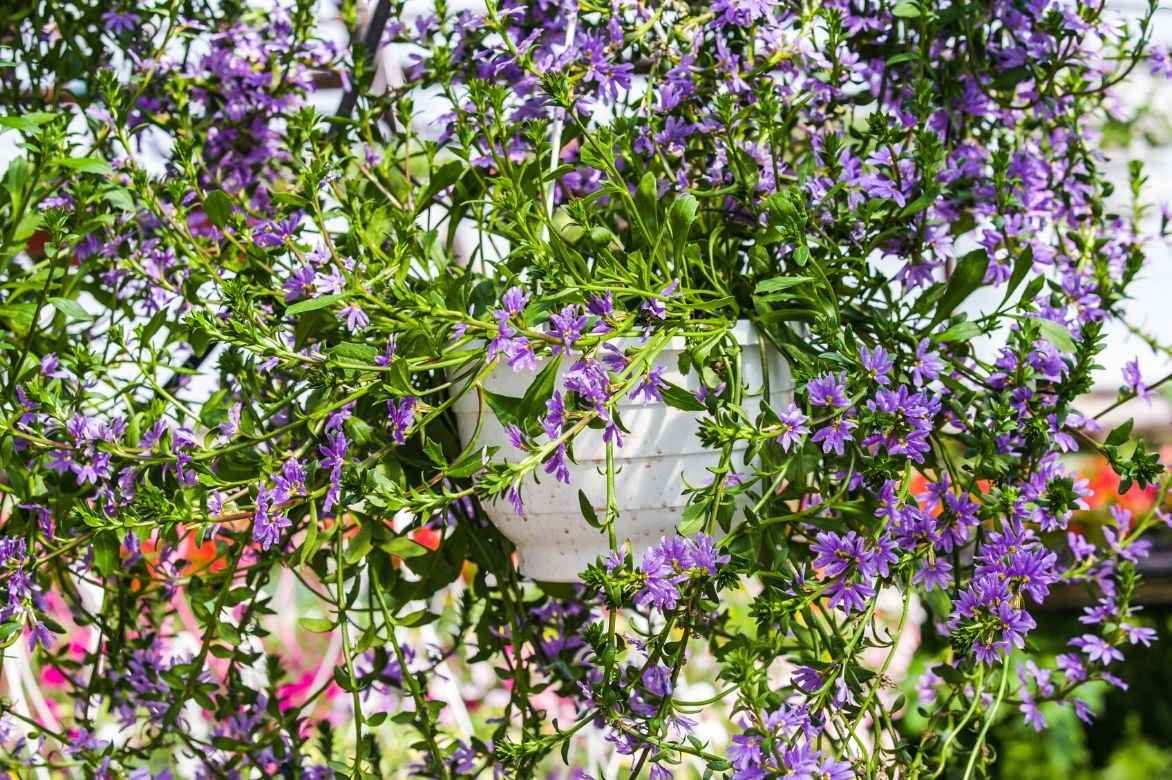
Hanging basket of Scaevola
In the ground
Plant about 4 to 5 Scaevola plug plants per m², either alone or mixed with other annual or perennial plants. Space the plants 30 to 40 cm apart in all directions and preferably plant in a staggered pattern.
- Soak the plugs for a few minutes
- Dig a hole 2 to 3 times larger than the size of the plug
- Add gravel, small stones, or clay balls for perfect drainage
- Mix the extracted soil with potting soil and coarse sand
- Place the plug in the centre of the hole, without burying the collar
- Bring the soil back to fill
- Firm down
- Water
Take advantage of our tips to successfully plant annual flowers in plug plants.
Read also
Planting annualsMaintenance and Care
Scaevola will be very generous to the gardener, provided it is regularly fed with fertiliser and adequately watered.
In pots
Watering must be much more frequent than in open ground. Even though it withstands drought fairly well, it should be watered regularly during the summer period, but without excess, allowing the medium to dry out between waterings. Watering should not be excessive (twice a week) to avoid root rot. Do not let water stagnate in the saucers or prefer pots with drainage.
Add liquid fertiliser for flowering plants, such as “geraniums”, to the watering water once a month throughout the growth period. Preferably use non-calcareous water.
During the season, pinch the stems to encourage the plant to ramify.
It is not hardy, so you can bring your pots indoors to protect them from frost in a cool, bright room to prolong flowering during autumn and winter. Take them out again in the following spring. During the winter period, reduce watering.
In open ground
Cultivation in open ground is possible. Watering should be regular, especially during hot summer days. It tolerates rather dry soil quite well. In the middle of the season, add a handful of compost by scratching it in to support flowering.
In cold regions, as the first frosts approach, uproot the plants; elsewhere, you can keep them by mulching well in winter.
Prune lightly in March.
Diseases and potential pests
Scaevola is rarely affected by other parasitic diseases of flowering plants. Simply avoid excess water and always allow the soil to dry out between waterings. Specimens grown indoors may be sensitive to mites, which are noticeable by leaf distortion, leaf drop, and the presence of spider web-like structures: as a precaution, maintain a humid atmosphere by regularly misting non-limestone water on the foliage.
Multiplication
Sowing is possible but tedious. Herbaceous cuttings in June from semi-woody stems are easier to carry out to ensure the longevity of this beautiful tender annual.
- Take 10 cm long stem tips without flowers
- Remove the lower leaves
- Plant the stems in pots filled with sowing compost and sand
- Keep moist but do not flood the substrate until rooting
- Place in a bright room or conservatory during winter
- In the following spring, plant them in the ground or in pots after the last frosts
Pairing ideas
The bushy and trailing silhouette of scaevola allows for numerous uses and associations in the ground or in pots, in all natural gardens or romantic ones!
In pots or window boxes, mix it with other annual plants such as Surfinia petunias, bacopas, small annual delphiniums, balcony geraniums, ipomoeas, diascias, or lobelias, adding height and lightness by incorporating some tufts of small fescues.
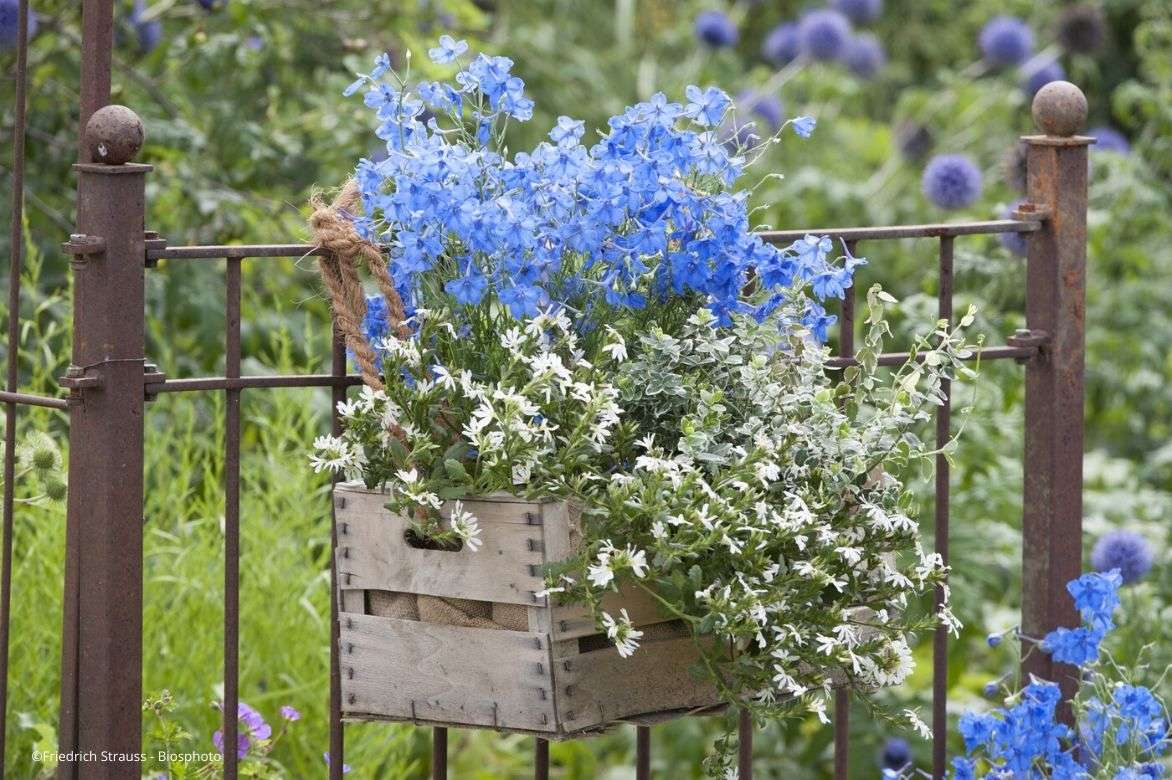
An example of association: a white Scaevola accompanied by a small Delphinium ‘Blue Diamond’ and a Euonymus fortunei ‘Emerald Gaiety’
It allows for the creation of flowering annual groundcovers, forming a delicate setting for taller summer-flowering perennials such as hollyhocks, agastaches, asters, cleomes, echinaceas, or immortelles. Within a summer bed, place it as colourful accents among dianthus and verbenas.
It will mask the bare stems of roses throughout the beautiful season.
At the edge, use it in combination with other low-growing plants such as Nemesia, lithodora, and aubrietas.
Useful resources
- The most beautiful annual plants are in our nursery!
- Follow all our tips to properly plant annuals.
- Get inspired to pair them well in a blue garden!
- Discover our best ideas to flower your balconies and terraces.
- Annual plants dress up the space they are given in just a few weeks: discover our solutions!
- Subscribe!
- Contents
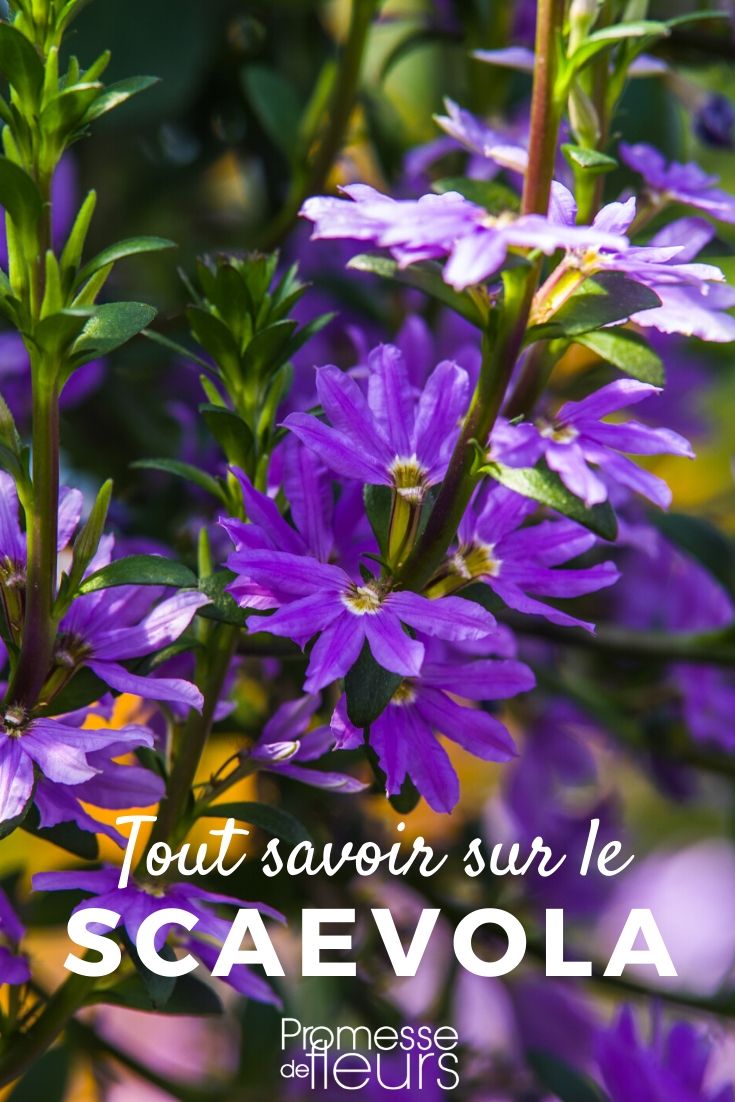































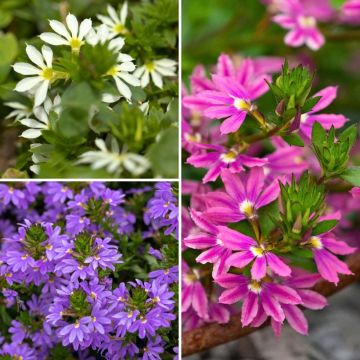
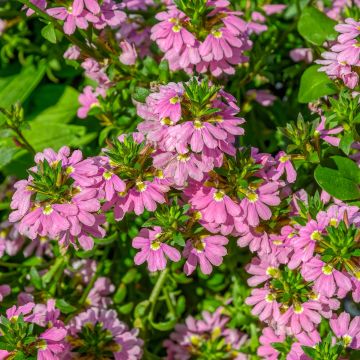


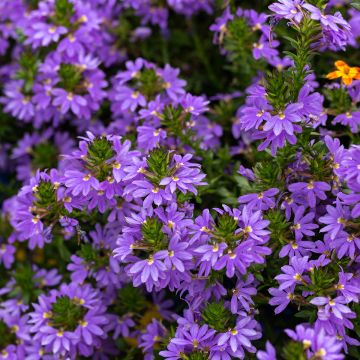
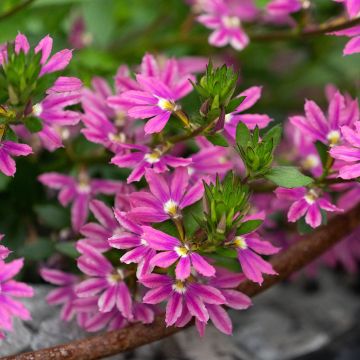
Comments